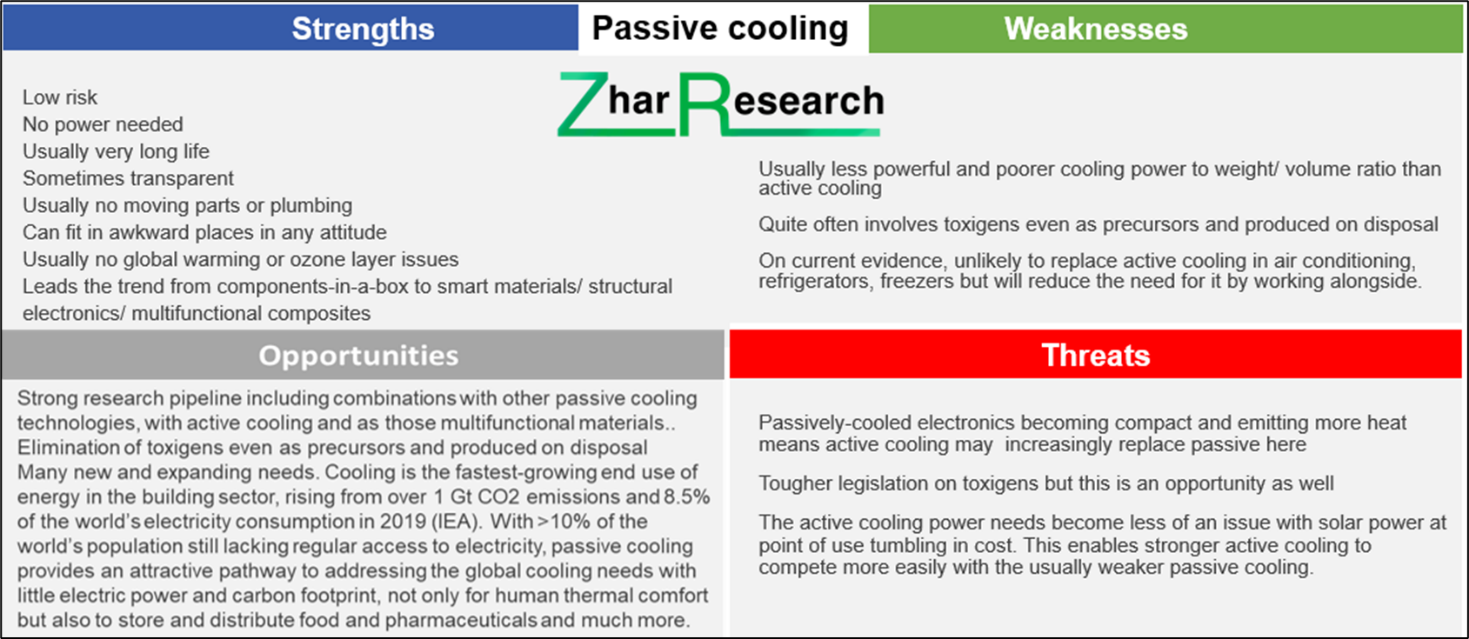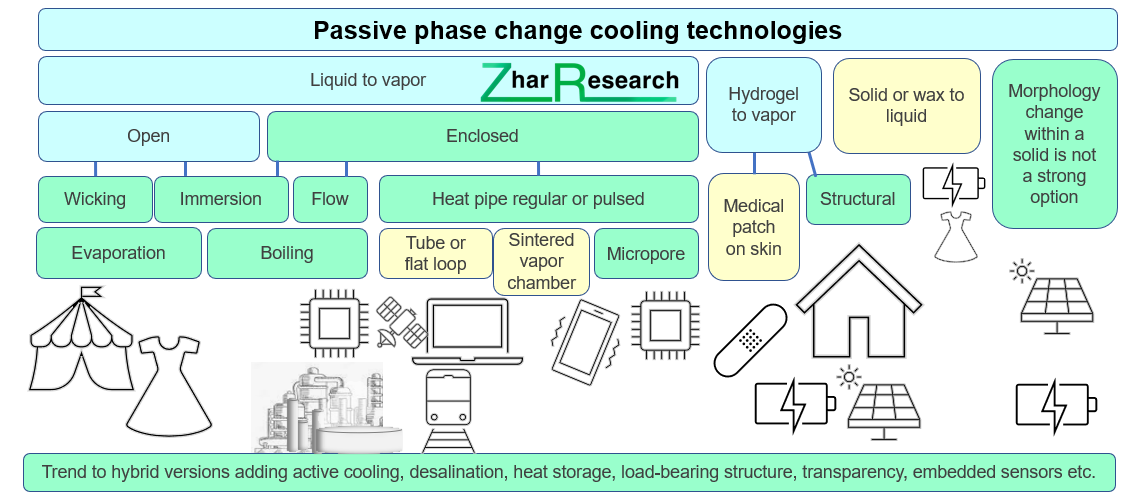Passive Cooling Will Become a Very Large Materials Market
Passive cooling is unpowered. It is a rapidly evolving technology almost quadrupling to a $177 billion in 2043 in the analysis of the new Zhar Research report, “Passive Cooling Materials and Devices: New Markets 2023-2043”. It is generating large markets for both familiar materials such as silicones in new forms and new materials. For example, this year Three Gorges University announced so-called Passive Daylight Radiative Cooling PDRC with hierarchically flexible porous PDMS films. It demonstrated excellent sub-ambient temperature drop of 14.9 °C under solar intensity of 910 W/m2. The report appraises the promising future of such things as PDRC best in temperate regions and deserts, not the humid tropics.
ICER
Increasingly, the new added-value materials are multi-mode (several forms of cooling) and multifunctional (load-bearing and windows etc.). For example, understand the potential of Insulated Cooling with Evaporation and Radiation ICER invented by MIT and composed of a solar reflector, a water-rich and IR-emitting evaporative layer, and a vapor-permeable insulating layer, reflecting the sun. It is not at its best in high relative humidity and at low altitude. Nevertheless, researchers calculate that it has great potential for saving food and energy over a wide range of climatic conditions.
Mainly for electronics and electrical engineering
The report finds that 54% of the future passive cooling value market will be in electronics and electrical engineering such as electric vehicles land, water and air and personal electronics. The authors include information, computing and telecommunications ICT in this and it is mostly outside buildings in contrast to the vapor compression cooling dominating the active (powered) cooling market. See Zhar Research report, “Active Cooling: Large New Materials, Systems Markets 2023-2043”. It reveals many new approaches and a trend to using passive and active cooling in one location.
Buildings
The use of passive cooling in buildings will be a major opportunity, rising to 44% of the passive cooling value market, mainly to assist active cooling, particularly alongside that vapor-compression air conditioning in early years. Vapor compression increasingly struggles with the requirements for much lower cost and greater effectiveness. That comes from such things as global warming, the quest for better living standards and the fact that most developing nations are in the tropics, not the temperate zones where most of the wealth lies today. Such active air conditioning has increased already problematic city temperatures by an extra 2C in some cases. In addition, it uses far too much electricity for most of the world to adopt it. True, the liquids involved in active cooling less often affect the ozone layer or global warming. However, when they escape some of the latest refrigerants produce toxic by-products or they need toxic precursors. Add the fact that traditional air conditioning can be noisy and you see many reasons why passive cooling partly replacing some active cooling will be valued. The ideal of fully solid-state cooling for most buildings is some way off but on that journey electrochemical passive cooling without refrigerant and other options have potential.
Benefits
Passive cooling is always silent, it needs no electricity and it is usually better environmentally. It is a gymnast in versatility, since it can take the form of adhesive, paint, gel, film, load-bearing structure, window and even be self-healing or self-cleaning. There are many emerging forms such as windows that darken in bright sunshine and radiate heat into outer space, even metamaterials that act as the opposite of a greenhouse.
JET and DSPT
Then there are Janus Emitter Technology JET and other Double-side Photonic Thermal DSPT systems. Mercifully, the report has a glossary at the start and also explains terms through the text. The focus is your materials and hardware opportunities, particularly new answers to the needs of potential users. The analysis, largely compressed into many new infograms, SWOT appraisals, forecast graphs and images is strongly based on the research pipeline and what suppliers will do next, set against current solutions and their identified limitations.
Personal devices and food in transit
Dr Peter Harrop, CEO of Zhar Research adds,
“Passive cooling will appear in more personal devices from your smartphone to your hydrogel medical or cosmetic cooling patch and later cooling apparel. Expect new passive cooling of food in transit as the world heats up. Passive cooling will help to address formidable challenges such more-capable, more heat-generating telecommunications systems and data centers. Include forthcoming 6G Communications infrastructure and client devices. One example will be passive cooling of active Reconfigurable Intelligent Surfaces across buildings. That RIS may even power unpowered devices such as IoT nodes using 6G Phase 2 around 2035, at last permitting their wide deployment, fit-and-forget. Before that, the 6G Phase 1 semi-passive RIS have no significant cooling problems but the base stations do have challenges.”
See Zhar Research reports, “6G Communications: Low Loss and Thermal Materials Markets 2023-2043” and "6G Communications: Reconfigurable Intelligent Surface Hardware Markets: Gigahertz, Terahertz and Optical 2023-2043".
Liquid cooling
Liquid immersion cooling without pumping, just convection, is headed to pass one billion-dollars in ten years. This does not include the rush to solar panels cooled on lakes and the sea which is a transfer of heat in one direction to something of high thermal capacity. Beyond this great success, Zhar Research advises that there are issues with those truly immersion cooling versions that require electrically insulating, non-flammable liquids. Some have toxic precursors and by-products or are expensive. This is another opportunity for you.
Smart materials
Mostly, passive cooling is becoming a world of smart materials and subsystems such as the flat, thin evaporative heat pipes called vapor chambers. Heat pipes span heavy industry down to the miniaturisation needed for individual one-kilowatt microchips coming soon. Heat pipes mostly use water under vacuum so it boils at a lower temperature but other opportunities involve a host of high-added value, fully-enclosed, evaporating liquids. In general, the passive cooling report finds huge activity in the research pipeline for phase-change materials PCM for passive cooling, notably liquid to vapor and solid to liquid. This sensibly reflects the widening applications and tougher requirements emerging.
Value-added materials opportunities
Dr Harrop adds,
“There are many opportunities to create billion-dollar businesses for the added value materials not just the subsystems involved. The identified research towards realistic major opportunities involves such things as graphene, graphite, silicone, silica, alumina, boron nitride, polyacrylates, polyacrylamides, polyvinyl alcohol, carbon nanotubes, titania and vanadium dioxide to name just a few. Increasingly, they will need to be in sophisticated, high-value-added forms such as aerogels, hydrogels, metamaterial patterns, hollow microspheres, nanoparticles, glasses, phase-change and polymer blends rather than just commoditised.”
Integration
Passive and active cooling increasingly work together in electric vehicles land, water and air. That is mainly the large batteries, the motors, the power electronics and climate control but even the central processing units now need cooling in more cases. Passive cooling is now intimately integrated into active cooling systems but most of its emerging value market is for use on its own.
Full picture
Uniquely presenting the latest, full picture of all this, with detailed forecasts and roadmaps, the Zhar Research report, “Passive Cooling Materials and Devices: New Markets 2023-2043” points you to your opportunities, gaps in the market and emerging competition.
Press release distributed by Pressat on behalf of Zhar Research , on Thursday 25 May, 2023. For more information subscribe and follow https://pressat.co.uk/
Passive Cooling Cooling Environment Materials Metamaterials Emerging Market New Technology Global Warming Construction Electricity Business & Finance Computing & Telecoms Consumer Technology Environment & Nature Manufacturing, Engineering & Energy Media & Marketing
Published By

anastasiams@zharresearch.com
https://www.zharresearch.com/
Dr Peter Harrop
peterharrop@zharresearch.com
Visit Newsroom
You just read:
Passive Cooling Will Become a Very Large Materials Market
News from this source:



